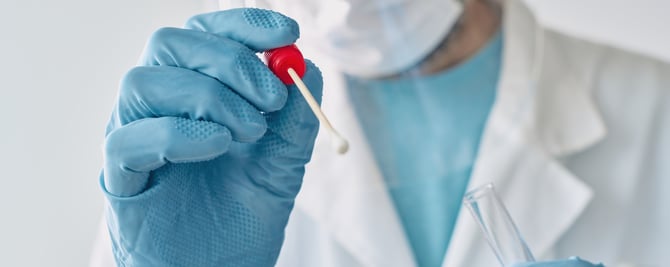The Future of Drug Testing: How Automated Drug Testing Systems Are Transforming Workflows
Automated drug testing is on the rise in both clinical and forensic settings. More and more laboratories are turning to automation to meet the demand for rapid, high-throughput drug screening. Modern clinical lab automation integrates robotics, computers and liquid handling to save time and reduce human error.1 Let’s examine how the trend towards automation impacts testing for drugs of abuse.
| “Automation has proven to be advantageous for drug testing labs. It reduces the amount of time spent on manual analysis and increases accuracy. Automated sample preparation, such as automated pipetting systems, can significantly reduce sample handling mistakes by ensuring precise delivery of samples into instruments or wells.” - Wolfe Inc2 |
What are the benefits of automated drug testing?
We can see the advantages of the automation trend clearly in drugs of abuse testing. Bench-top analyzers and LC-MS (liquid chromatography–mass spectrometry) platforms now handle entire workflows, from sample reception to electronic results reporting. This ensures faster turnaround and more reliable data.
As well as improving speed and accuracy, automation in drugs of abuse testing helps improve cost-effectiveness and legal compliance:3
- Automated testing allows for high-throughput drug screening, enabling labs to quickly process large volumes of samples.
- Automated testing platforms can screen for a wide range of substances simultaneously, increasing diagnostic scope.
- Clinical lab automation systems can detect drugs at very low concentrations, improving early and accurate identification.
- Electronic data capture, with barcoding and encrypted sharing, replaces paper forms. This reduces transcription errors and makes results instantly available to courts of law or employers.
- Automated scheduling, specimen tracking and result distribution support real-time chain-of-custody tracking and also reduce labs’ reliance on paper-based documentation.
- End-to-end automation, often managed by LIMS (laboratory information management software), speeds up the workflow and ensures compliance with legal requirements through audit trails and electronic logs.
- Automation ensures standardized protocols, which improves reproducibility across different labs.
- By minimizing manual handling, automated systems lower labor requirements and reduce long-term operational costs.
Examples of automated drug testing workflows:

Atellica® Solution - Siemens Healthineers3b
Workflow agility:
- Anticipate accreditation requirements with integrated assay studies in the Laboratory Evaluation Suite.
- Enable automation functions and standardize system operation across your network.
- Simplify day-to-day operations with a tile-based tablet interface that prioritizes operator tasks.

Thermo ScientificTM IndikoTM Plus - Thermo Fisher Scientific3c
- Randomly test more than 20 drugs at a time, with the ability to add specimens at any time during a run.
- Run up to 350 tests per hour (or 175 tests per hour for Drugs of Abuse 2 reagent systems) and up to 54 specimens per run.
- First results available in approximately 12 minutes, once the instrument is up and running, with next results available in approximately 30 seconds.
Automation of laboratory analyzers
Laboratory analyzers themselves are also highly automated. For example, immunoassay systems can process large batches of urine or saliva samples with minimal user input. By integrating sample preparation, reaction, and detection, systems like this bring laboratory-level accuracy to PoC (point of care) or onsite testing.4,5
Automated analyzers (immunoassay or MS-based) speed up screening and greatly reduce manual errors.1
Automation in mass spectrometry platforms
High-end mass spectrometry platforms are another pillar of automation. Forensic and clinical labs are increasingly adopting LC–MS/MS and LC–MSn (liquid chromatography–multistage mass spectrometry) systems that can rapidly screen hundreds of compounds. There is even a push-button LC-MSn solution designed for non-experts available on the market today.6
By automating LC-MS analyses, these systems ensure consistent identification of new psychoactive substances and eliminate tedious MS/MS tuning.1
Forensic and clinical workflow automation
Automating the workflow also strengthens data integrity and turnaround. Digital reporting platforms now allow test results to be routed instantly to stakeholders such as courts or employers. For example, a forensic lab in California implemented RPA (robotic process automation) to generate and email reports. As a result, “our daily repetitive tasks are already done when we walk in the office in the morning”, improving their turnaround for time-sensitive results.7
Case study in automated drug testing: Human resources screening firm
In the workplace drug testing sector, a cloud-based portal built for a human resources screening firm has demonstrated significant benefits. This portal links collection sites, labs and clients, automatically routing orders to labs and importing results via web services.8
After deploying the system, the company experienced:8
- a 75% reduction in testing cycle time;
- 45% lower costs;
- no manual data errors; and
- Effective random-test assignment for compliance.
The role of reagents and suppliers in clinical lab automation
The need for quality reagents and calibrators underlies all automated assays. Medix Biochemica highlights that assay accuracy “hinges on using high-quality reagents that have been validated for the application”.9
| As a leading in vitro diagnostics raw materials supplier, Medix Biochemica offers matched antibody–antigen pairs and positive/negative controls for nearly 50 drugs of abuse. We offer exceptional batch-to-batch consistency and scalable supply, so that the new automated test kits yield reliable results.9 |
It’s important that high-performance analyzers be paired with rigorously tested reagents. Our broad portfolio, which includes ELISA (enzyme-linked immunosorbent assay) antigens and instrument reagents, supports both novel assays and routine screening platforms.
By supplying these critical raw materials and technical support, Medix Biochemica helps bring new products to market sooner and enables next-generation automated testing solutions.9
Future outlook: The clinical workflow automation revolution
Automated drug testing is evolving rapidly. Labs and testing programs are using automation technologies to meet stricter regulations and higher volume requirements. As the industry continues to adopt robotics and digital tools, labs can expect to benefit from faster turnaround, fewer errors and improved compliance.
As these automated drug testing systems begin to revolutionize clinical and workplace toxicology workflows, Medix Biochemica looks forward to partnering with our customers to help them stay at the cutting edge of these advances.
References:
- Armbruster DA, Overcash DR, Reyes J. Clinical chemistry laboratory automation in the 21st century - Amat victoria curam (Victory loves careful preparation). Clin Biochem Rev. 2014;35(3):143-153. Accessed September 22, 2025. https://www.ncbi.nlm.nih.gov/pmc/articles/PMC4204236/.
- The evolution of drug testing - New technologies and advanced screening methods. Wolfe Inc. Accessed September 22, 2025. https://wolfeinc.com/the-evolution-of-drug-testing-new-technologies-and-advanced-screening-methods/.
- Expert opinion. Anthony Austin, Global Marketing Manager, Medix Biochemica. September 2025.
3b. Atellica® Solution. Siemens Healthineers. Accessed September 30, 2025. https://www.siemens-healthineers.com/en-za/laboratory-diagnostics/clinical-chemistry-and-immunoassay-systems/atellica-solution-analyzers.
3c. Thermo Scientific Toxicology on IndikoTM Benefit Flyer. Thermo Fisher. Accessed September 30, 2025. https://documents.thermofisher.com/TFS-Assets/CDD/brochures/CDD_Brochure_Indiko%20Reagents_TOX_Tox%20on%20Indiko%20Benefits_NDX_CDD-FR-MTL-0550_EN_WW.pdf. - Evidence MultiSTAT. Randox Toxicology. Accessed September 22, 2025. https://randoxtoxicology.com/analysers/evidence-multistat/.
- The smarter way to test for drugs of abuse. Siemens Healthineers. Accessed September 22, 2025. https://www.siemens-healthineers.com/en-us/drug-testing-diagnostics/additional-resources/on-site-automated-testing.
- Toxtyper®. Bruker. Accessed September 22, 2025. https://www.bruker.com/en/products-and-solutions/mass-spectrometry/ms-solutions/toxtyper.html.
- Save time with report generation. Automate by Fortra. Accessed September 22, 2025. https://automate.fortra.com/resources/case-studies/pacific-toxicology-laboratories-saves-time-automate.
- Lab testing platform: A comprehensive cloud portal for managing, tracking, and accessing drug testing data. Empeek. Accessed September 22, 2025. https://empeek.com/case-studies/lab-testing-platform-a-comprehensive-cloud-portal-for-managing-tracking-and-accessing-drug-testing-data/.
- Drugs of abuse. Medix Biochemica. Accessed September 22, 2025. https://info.medixbiochemica.com/drugs-of-abuse.




